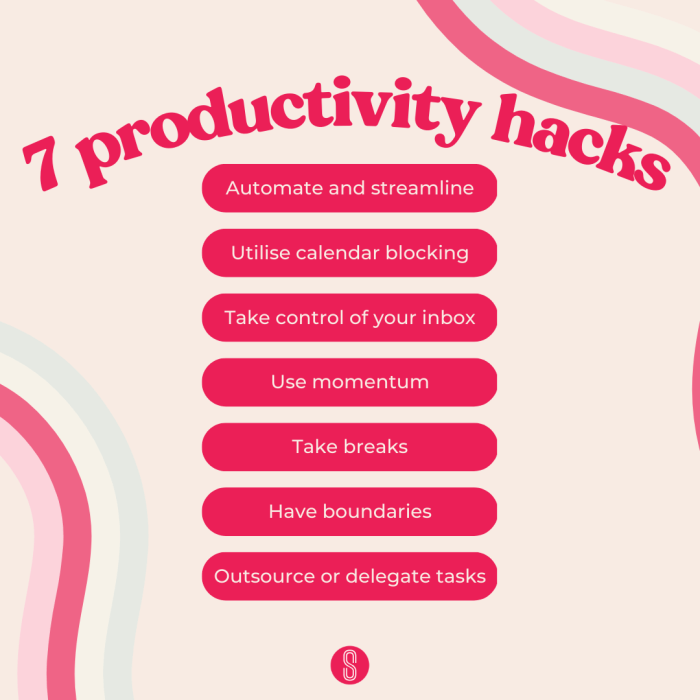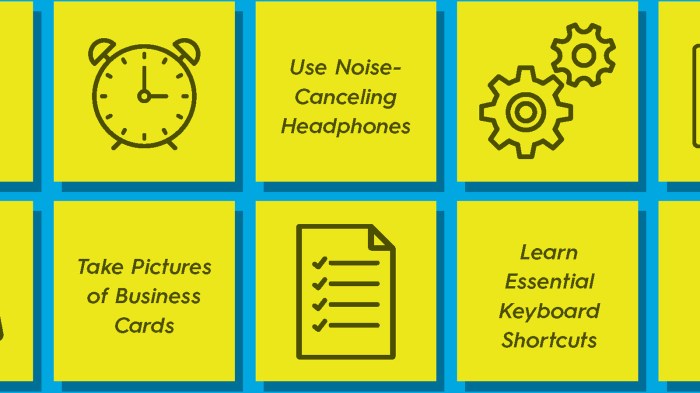Productivity Hacks sets the stage for this enthralling narrative, offering readers a glimpse into a story that is rich in detail with american high school hip style and brimming with originality from the outset.
Get ready to dive into the world of productivity like never before, as we explore innovative tools, time management techniques, workspace organization, mindfulness practices, and health tips to revolutionize your workflow and maximize your potential.
Productivity Tools

In today’s fast-paced world, professionals rely on a variety of productivity tools to help them work smarter, not harder. These tools are designed to streamline work processes, increase efficiency, and ultimately boost productivity.
Project Management Tools
- Trello: A popular project management tool that allows teams to collaborate, organize tasks, and track progress in a visually appealing way.
- Asana: Another great project management tool that helps teams stay organized, assign tasks, set deadlines, and communicate effectively.
- Jira: Ideal for software development teams, Jira helps track bugs, issues, and tasks in an agile environment.
Time Tracking Tools
- Harvest: A time tracking tool that helps professionals track billable hours, manage projects, and generate insightful reports.
- RescueTime: This tool provides detailed insights on how time is spent on the computer, helping users identify productivity bottlenecks.
- Toggl: A simple time tracking tool that allows users to track time spent on different tasks and projects effortlessly.
Note-taking Tools
- Evernote: A versatile note-taking app that allows users to capture ideas, create to-do lists, and organize information across devices.
- OneNote: Microsoft’s note-taking tool that offers a digital notebook for capturing ideas, taking notes, and collaborating with others.
- Notion: A powerful all-in-one workspace that combines note-taking, project management, and collaboration tools in one platform.
Time Management Techniques
Effective time management is crucial for maximizing productivity and achieving goals. There are various techniques and methods that can help individuals manage their time efficiently. Let’s explore some of the most popular time management techniques below.
Pomodoro Technique
The Pomodoro Technique is a time management method developed by Francesco Cirillo in the late 1980s. It involves breaking work into intervals, typically 25 minutes long, separated by short breaks. After four intervals, a longer break of 15-30 minutes is taken. This technique helps improve focus and productivity by working in short, concentrated bursts followed by brief rest periods.
Eisenhower Matrix
The Eisenhower Matrix, also known as the Urgent-Important Matrix, is a tool for prioritizing tasks based on their urgency and importance. Tasks are categorized into four quadrants: urgent and important, not urgent but important, urgent but not important, and neither urgent nor important. This method helps individuals differentiate between tasks that are truly important and those that are simply demanding immediate attention.
Time Blocking
Time blocking involves scheduling specific blocks of time for different tasks or activities. By allocating dedicated time slots for particular tasks, individuals can focus on one task at a time without distractions. This method helps improve efficiency and prevents multitasking, leading to better productivity.
Getting Things Done (GTD)
The Getting Things Done (GTD) method, developed by David Allen, is a productivity system that emphasizes capturing, clarifying, organizing, and reviewing tasks and commitments. By collecting all tasks and ideas in a trusted system, breaking them down into actionable steps, and regularly reviewing and updating them, individuals can stay organized and focused on their priorities.
Tips for Prioritizing Tasks
- Use the Eisenhower Matrix to classify tasks based on urgency and importance.
- Set clear goals and deadlines for each task to prioritize effectively.
- Focus on completing high-priority tasks first before moving on to less critical ones.
- Break down large tasks into smaller, manageable steps to avoid feeling overwhelmed.
- Regularly review and adjust priorities as needed to adapt to changing circumstances.
Workspace Organization
Creating a well-organized workspace is crucial for boosting productivity. A clutter-free environment can help improve focus and efficiency, leading to better outcomes. Here are some tips to declutter and optimize your workspace for maximum productivity.
Declutter Your Space
To start, clear out any unnecessary items that are taking up space on your desk or in your office. Keep only the essentials within arm’s reach to minimize distractions and create a clean, focused environment.
Optimize Your Layout
Arrange your workspace in a way that suits your work style. Consider using desk organizers, shelves, or file cabinets to keep things tidy and easily accessible. A well-planned layout can save time and energy by reducing the need to search for tools or documents.
Create a Distraction-Free Environment
Eliminate distractions by setting boundaries and establishing a dedicated work area. Use noise-canceling headphones, desk dividers, or even a “do not disturb” sign to signal your focus time to others. By creating a quiet and distraction-free workspace, you can enhance your productivity and concentration levels.
Mindfulness and Productivity
Mindfulness practices can significantly impact productivity by helping individuals stay focused, reduce distractions, and enhance overall mental clarity. By incorporating mindfulness techniques into daily routines, individuals can improve their ability to concentrate on tasks, manage stress effectively, and make better decisions.
Mindfulness Meditation for Improved Focus
Mindfulness meditation is a powerful tool that can enhance focus and concentration. By practicing mindfulness meditation regularly, individuals can train their minds to stay present and fully engaged in the task at hand. This can help reduce mind-wandering, increase attention span, and boost productivity levels.
- Focus on your breath: Start by focusing on your breath and bringing your attention to the present moment. This can help calm the mind and increase awareness.
- Body scan meditation: This technique involves focusing on different parts of the body, helping to release tension and promoting relaxation, which can improve focus and concentration.
- Walking meditation: Take a mindful walk, paying attention to each step you take and the sensations in your body. This can help clear the mind and improve mental clarity.
Incorporating Mindfulness into Daily Routines
Integrating mindfulness into daily routines can have a significant impact on productivity levels. Simple practices such as mindful breathing exercises, short meditation breaks throughout the day, and mindful eating can help individuals stay present, reduce stress, and enhance focus.
- Set aside time for mindfulness: Allocate specific times during the day for mindfulness practices, such as morning meditation or mindful breaks between tasks.
- Use mindfulness apps: There are various mindfulness apps available that can guide you through meditation sessions and provide reminders to stay present throughout the day.
- Practice gratitude: Take a moment each day to reflect on things you are grateful for, promoting a positive mindset and reducing stress levels, which can improve productivity.
Health and Productivity: Productivity Hacks

Maintaining good physical health is crucial for maximizing productivity in the workplace. When we take care of our bodies, we are better equipped to handle the demands of our jobs, think clearly, and stay focused throughout the day.
Regular Exercise, Productivity Hacks
Regular exercise is not only beneficial for our physical health but also plays a significant role in boosting productivity. Engaging in physical activity helps increase energy levels, improve mood, and enhance cognitive function. Whether it’s a quick workout at the gym, a brisk walk during lunch break, or stretching exercises at your desk, incorporating regular exercise into your routine can have a positive impact on your productivity.
Proper Nutrition
Eating a well-balanced diet is essential for maintaining optimal productivity. Fueling your body with nutritious foods can help sustain energy levels, improve concentration, and enhance overall performance. Make sure to include a variety of fruits, vegetables, lean proteins, and whole grains in your meals to support both your physical and mental well-being.
Adequate Sleep
Getting enough rest is crucial for productivity. Lack of sleep can lead to decreased cognitive function, poor decision-making, and increased stress levels. Aim for 7-9 hours of quality sleep each night to ensure that your body and mind are rejuvenated for the day ahead. Establishing a consistent bedtime routine and creating a restful sleep environment can help improve the quality of your sleep and enhance your productivity during waking hours.